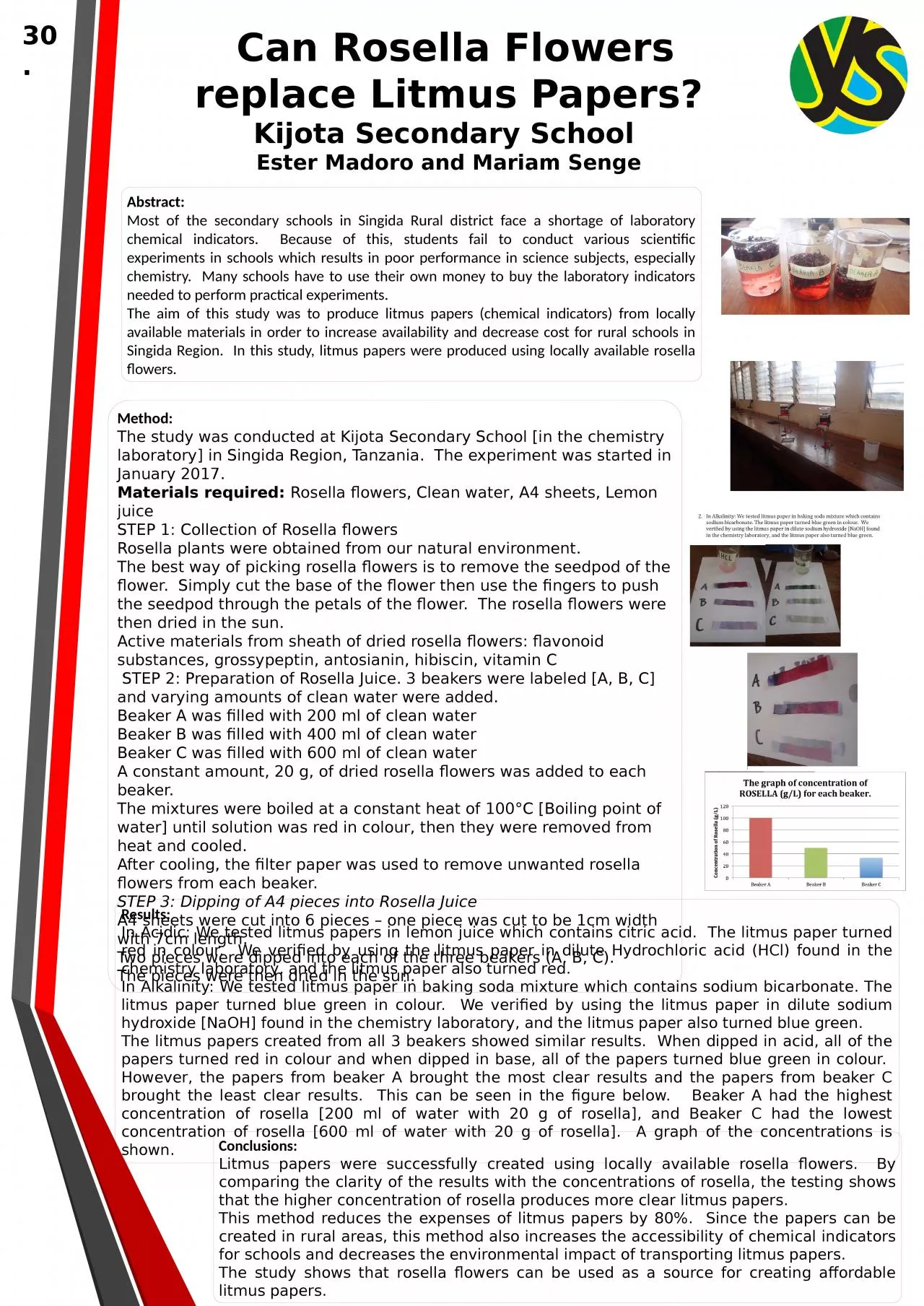

Kijota Secondary School Ester Madoro and Mariam Senge Method The study was conducted at Kijota Secondary School in the chemistry laboratory in Singida Region Tanzania The experiment was started in January 2017 ID: 930189
Download Presentation The PPT/PDF document "30. Can Rosella Flowers replace Litmus..." is the property of its rightful owner. Permission is granted to download and print the materials on this web site for personal, non-commercial use only, and to display it on your personal computer provided you do not modify the materials and that you retain all copyright notices contained in the materials. By downloading content from our website, you accept the terms of this agreement.
Slide1
30.
Can Rosella Flowers replace Litmus Papers?Kijota Secondary School Ester Madoro and Mariam Senge
Method
:The study was conducted at Kijota Secondary School [in the chemistry laboratory] in Singida Region, Tanzania. The experiment was started in January 2017. Materials required: Rosella flowers, Clean water, A4 sheets, Lemon juiceSTEP 1: Collection of Rosella flowersRosella plants were obtained from our natural environment.The best way of picking rosella flowers is to remove the seedpod of the flower. Simply cut the base of the flower then use the fingers to push the seedpod through the petals of the flower. The rosella flowers were then dried in the sun.Active materials from sheath of dried rosella flowers: flavonoid substances, grossypeptin, antosianin, hibiscin, vitamin C STEP 2: Preparation of Rosella Juice. 3 beakers were labeled [A, B, C] and varying amounts of clean water were added.Beaker A was filled with 200 ml of clean waterBeaker B was filled with 400 ml of clean waterBeaker C was filled with 600 ml of clean waterA constant amount, 20 g, of dried rosella flowers was added to each beaker. The mixtures were boiled at a constant heat of 100°C [Boiling point of water] until solution was red in colour, then they were removed from heat and cooled.After cooling, the filter paper was used to remove unwanted rosella flowers from each beaker.STEP 3: Dipping of A4 pieces into Rosella JuiceA4 sheets were cut into 6 pieces – one piece was cut to be 1cm width with 7cm length. Two pieces were dipped into each of the three beakers (A, B, C). The pieces were then dried in the sun.
Results:In Acidic: We tested litmus papers in lemon juice which contains citric acid. The litmus paper turned red in colour. We verified by using the litmus paper in dilute Hydrochloric acid (HCl) found in the chemistry laboratory, and the litmus paper also turned red. In Alkalinity: We tested litmus paper in baking soda mixture which contains sodium bicarbonate. The litmus paper turned blue green in colour. We verified by using the litmus paper in dilute sodium hydroxide [NaOH] found in the chemistry laboratory, and the litmus paper also turned blue green. The litmus papers created from all 3 beakers showed similar results. When dipped in acid, all of the papers turned red in colour and when dipped in base, all of the papers turned blue green in colour. However, the papers from beaker A brought the most clear results and the papers from beaker C brought the least clear results. This can be seen in the figure below. Beaker A had the highest concentration of rosella [200 ml of water with 20 g of rosella], and Beaker C had the lowest concentration of rosella [600 ml of water with 20 g of rosella]. A graph of the concentrations is shown.
Conclusions:Litmus papers were successfully created using locally available rosella flowers. By comparing the clarity of the results with the concentrations of rosella, the testing shows that the higher concentration of rosella produces more clear litmus papers. This method reduces the expenses of litmus papers by 80%. Since the papers can be created in rural areas, this method also increases the accessibility of chemical indicators for schools and decreases the environmental impact of transporting litmus papers. The study shows that rosella flowers can be used as a source for creating affordable litmus papers.
Abstract:Most of the secondary schools in Singida Rural district face a shortage of laboratory chemical indicators. Because of this, students fail to conduct various scientific experiments in schools which results in poor performance in science subjects, especially chemistry. Many schools have to use their own money to buy the laboratory indicators needed to perform practical experiments. The aim of this study was to produce litmus papers (chemical indicators) from locally available materials in order to increase availability and decrease cost for rural schools in Singida Region. In this study, litmus papers were produced using locally available rosella flowers.